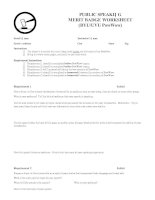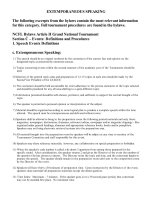Tài liệu Public Speaking for Kids pdf
Bạn đang xem bản rút gọn của tài liệu. Xem và tải ngay bản đầy đủ của tài liệu tại đây (349.22 KB, 5 trang )
Public Speaking for Kids!
"Tell 'em what you're going to tell, 'em; tell 'em;
and then tell 'em what you told 'em."
Vocabulary
Articulation – The act of producing a speech sound. How your total
vocal process works. There are several steps to this entire process.
First, you need air from the lungs, your vocal cords in your larynx
must be working, your mouth and tongue must be in sync, and you
have to make sure that you have got some saliva in your mouth to
keep things oiled.
Body Language - nonverbal, usually unconscious, communication
through the use of postures, gestures, facial expressions etc.
Pronunciation – the way a word sounds and is spoken, phonics, the
result of producing a sound
Variance – the ability to change the pitch, volume, speed etc of your
speech to keep your voice interesting
Pitch - pitch refers to the highs and lows of your voice. Whatever you
do, avoid a monotone!
The 5 Organs of Speech
•
The tongue
•
The lips
•
The soft palate
•
The hard palate
•
The teeth
The Process of writing a speech
1. Things to think about
a. Who is your audience?
b. What’s the point? - write a focus statement
c. Where are you speaking?
d. How much time do you have?
e. What is the occasion? serious, humorous, business
2. Write a first draft
3. Read aloud, edit and rewrite – use a buddy to help with this
4. The copy you read from should be large font, double spaced, and
written with indicators for yourself – stress this point, slow down
here, pause etc.
5. Practice! Practice! Practice!
The Process of Listening and Evaluating a Speech
As a Listener...
* Do not judge the person by his or her
speech. Be genuine and sincere.
* Do not practice or think about your
comments while the person is speaking.
* While the person is speaking, have a
positive regard for the speaker.
* Try to understand the speaker from his
or her point of view.
As an Evaluator?
* Share feelings and thoughts with the speaker.
* Make "I" statements (e.g., "I think your speech was?" or "I
feel you need to?")
* Be specific.
* Be constructive, not destructive.
* Remember that each speaker is unique.
* Comment only on the speech - not on the speaker.
* Do not project your own biases onto the speech.
When offering a critique do not:
* Drift off during the speech and then pretend to have all of
the right comments.
* Try to show-off by listing trivial concerns or to nit-pick.
* Make comments directed at speaker's personality.
* Don’t let someone "get away" with a flawed speech. Take
the personal risk of being honest.
Evaluation Worksheet
Each of these letters stands for an area of the speech evaluation, each
being a critical part of a person's speech. After each letter, you will
award a written number on a 1 to 5 scale.
"1" is very poor. "2" is okay. "3" is average. "4" is very good.
"5" excellent. "D/A" means does not apply to the speech.
A= Analysis - how well does the speaker understand the topic?
R = Reasoning - is the speech reasonable? Do you believe it?
E = Evidence - what was the quality of the support material offered?
Did it justify the claim made?
O = Organization - did the speech have a clear beginning, body, and
ending. Did it "flow?"
D = Delivery - overall, how was the delivery?
Dl = Relaxed - did the speaker seem relaxed?
D2 = Eye contact - was there sufficient eye contact?
D3 = Physical Relationship - What was the physical
relationship with the audience? Did you feel comfortable with
the speaker, or did he or she make you nervous?
D4 = Vocal quality - was the rate, tone, pitch and volume
appropriate to the subject material?
C = Comment - just write down a one or two-sentence comment on
anything that struck you as being important.
K-2 activity
Bring in something for show and tell. Tell the class 3 things about the
item you brought in. Practice smiling while you talk, using full
sentences, and having good posture while you speak. Practice with a
friend before you give your speech to the class!
3-5 activity
1. Choose a poem and read through it carefully.
2. Try reading it out loud.
3. Practice using vocal and facial expression while reading out loud.
Watch yourself in a mirror or film yourself presenting the poem
and watch it.
4. Present the poem to a friend and ask them to use the evaluation
worksheet to help you improve.
5. Remembering what you learn in the public speaking passport,
present your poem to the class.
3-8 activity
The next time you really want something from your parents, try this
approach!
1. Write a list of reasons you want the item
2. Write down the facts about the item – include
things like the price, where it can be purchased,
etc.
3. Write down why you need/want this product
4. Write down how you will benefit from this product
5. Write down how they might benefit from this
product
6. Arrange these points into a speech
7. Practice giving the speech using tips that you
learned in the passport
8. Present the speech to your parents!
5-8 activity
* Label the organs of speech on the diagram
* Conduct further research on one of the organs of speech
* From your research write a speech to inform your classmates
about what you have learned.
* Be creative when writing the speech – what will capture and
keep your audience’s attention?
* As a listener – evaluate your classmates speeches using the
worksheet
The Organs of Speech









